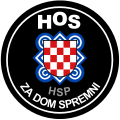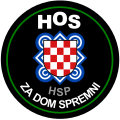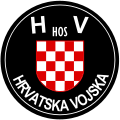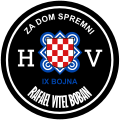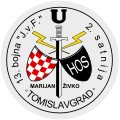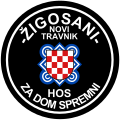Hrvatske obrambene snage
|
|||
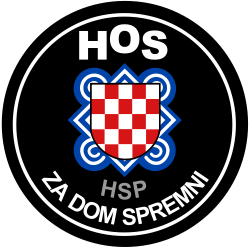
|
|||
| guide | |||
|---|---|---|---|
| Commander in Chief : | Dobroslav Paraga | ||
| Military Commander: | Ante Paradžik , later Blaž Kraljević | ||
| Military leadership: | Croatia: Ante Paradžik Bosnia and Herzegovina: Blaž Kraljević |
||
| Headquarters: |
Croatia : Zagreb Bosnia: Zenica Herzegovina: Ljubuški |
||
| Military strength | |||
| Active soldiers: | Croatia: 10,000 Bosnia: 5,000 |
||
| Conscription: | No | ||
| Eligibility for military service: | |||
| history | |||
| Founding: | Croatia: June 25, 1991 Bosnia: early 1992 |
||
| Resolution: | Croatia: December 21, 1991 Bosnia and Herzegovina: August 21, 1992 de facto 1993 |
||
| Highest manpower: | a total of 15,000 | ||
The Hrvatske obrambene snage ( Croatian for Croatian Defense Forces ), HOS for short , was a Croatian paramilitary organization at the beginning of the Croatian and Bosnian war from 1991 to 1993 , alongside the regular units of the Croatian Army (HV) and the Croatian Defense Council (HVO).
In addition to Croatians , Bosniaks and foreign fighters from Europe and overseas fought in the ranks of the HOS . The stated goals were the defense and conquest of Croatian territories and the restoration of a Greater Croatia , including Bosnia and Herzegovina . The equality of the abbreviation HOS with the abbreviation for the Army of the Independent State of Croatia (there HOS for Hrvatske oružane snage ) was probably chosen deliberately.
history
Emergence
In February 1990 Dobroslav Paraga re-established the Croatian Party of Law (HSP). In 1991 the HOS was formed as a paramilitary wing of the then fascist HSP, whose politicians Anto Đapić and Dobroslav Paraga became HOS commanders. The HOS, which saw their roots in the traditions of the fascist Ustasha and wanted to inherit it, became a hodgepodge of volunteer fighters for the defense and conquest of Croatian territories in Croatia and Bosnia-Herzegovina, including many foreign mercenaries and right-wing radicals .
Croatian war
At the beginning of the Croatia war and before the establishment and restructuring of the Croatian armed forces , the HOS fought alongside the Croatian police against the Yugoslav People's Army , the Army of the Republic of Serb Krajina and Serbian Chetniks . The military commander was Ante Paradžik at the beginning , later Blaž Kraljević . According to its own information, the HOS had over 10,000 fighters (the Croatian government spoke of 2,000 fighters), organized in sub-manned battalions and the 300-man Crna legija (Black Legion) unit in Vukovar. Dobroslav Paraga was arrested by the Croatian government in November 1991. The HOS were banned in Croatia on December 21, 1991 by the Croatian government under Franjo Tuđman and their forces were partially integrated into the regular Croatian Army (HV).
The HOS gained notoriety for their fanatical bravery in the battles at the siege of Dubrovnik and the battle for Vukovar , but also for the ruthless mistreatment of Serb civilians.
Bosnian War

After the ban in Croatia, the military commander Blaž Kraljević reorganized the HOS in Bosnia-Herzegovina. During the Bosnian War , the HOS were allied with the Army of the Croatian Republic of Herceg-Bosna (HVO) and until 1992 with the Army of the Republic of Bosnia and Herzegovina (ARBiH) and fought with them against the army of the Republika Srpska and Serbian Chetniks . In May 1992 it became an official part of the ARBiH. The HOS had a total strength of about 5000 men in the Bosnian War, of which the proportion of Muslim Bosniaks was about 30%. Under Kraljević, the HOS opposed the policy of the Croatian government, which “only” sought an annexation of the Croatian Republic of Herceg-Bosna to the Republic of Croatia. Kraljević was shot dead on August 9, 1992 by members of the HVO (including soldiers from the Kažnjenička bojna ) at a checkpoint in Mostar- Kruševo. The HOS in Bosnia-Herzegovina were dissolved on August 21, 1992 and their forces were partially integrated into the HVO or the ARBiH . In fact, the HOS was not completely dissolved until 1993.
The HOS became known for their struggles over the regions of Bosanski Brod , Konjic , Mostar , Novi Travnik , and Zenica , but also for riots against Bosnian-Serb civilians. In 1993 the HOS briefly ran the Dretelj camp in Herzegovina , where Serbs and Bosniaks were tortured and murdered , but after a short time handed over the camp management to the HVO.
Units (selection)
- 1. bojna "Ivan vitez Brdar" (1st Battalion "Ivan Knight Brdar") - Livno
- 2. bojna "Stojan Vujnović Srbin" (2nd Battalion "Stojan Vujnović - The Serb") - Domaljevac
- 4th bojna HOS-a (4th Battalion of HOS)
- 6th bojna "Marijan Baotić" (6th Battalion "Marijan Baotić") - Vinkovci
- IX. bojna " Rafael vitez Boban " (IX Battalion "Rafael Knight Boban") - Split
- 1st satnija " Ante Paradžik " (1st company "Ante Paradžik") - Jasenovac
- Vukovarska satnija HOS-a (Vukovar Company of the HOS) - Vukovar
- 13th bojna Jure vitez Francetić (13th Battalion “Jure Knights Francetić”) - Tomislavgrad
- "Vitezovi" ("The Knights") - Vitez
- 101st bojna “Do Drine” (101st Battalion “To the Drina !”) - Sarajevo
- 19th bojna "Jure vitez Francetić" (19th battalion "Jure Ritter Francetić") - Gospić
- “Crni Vukovi” (“Black Wolves”) - Kalesija
- “Žigosani” (“The Marked” ) - Novi Travnik
- Satnija "Lovac" ("Hunter" Company) - Ljubuški
- Samostalna satnija osiguranja (Independent Security Company) - Zagreb
- Mostarska bojna HOS-a (Mostar Battalion of the HOS) - Mostar
- Ljubuška satnija HOS-a (Ljubuški Company of HOS) - Ljubuški
- Zenička satnija HOS-a (Zenica Company of HOS) - Zenica
- Tuzlanska satnija HOS-a (Tuzla Company of HOS) - Tuzla
- Čapljinska bojna HOS-a (Čapljina Battalion of HOS) - Čapljina
- Kakanjska Satnija HOS-a (Company of HOS Kakanj) - Kakanj
Symbols and badges (selection)
The names, symbols and badges used by the HOS indicate a reference to the Ustasha and the Independent State of Croatia (NDH) . So found z. For example, on almost all badges the HOS motto ZA DOM SPREMNI ( Ready for the homeland ), which was also the motto of the Ustasha, and the capital letter U and the Croatian coat of arms , starting with a first silver (white) field, like it was used in the NDH. The abbreviation HSP for the Croatian Party of Law is also often found .
Flag and general badge
Blaž Kraljević (Military Commander)
Badges of units
2nd Battalion "Stojan Vujnović Srbin" ( Domaljevac )
Personalities
- Jean-Michel Nicollier (1966–1991), French volunteer
literature
- Damir Markuš: "58": HOS u obrani Vukovara i Bogdanovaca ["58": The HOS in the defense of Vukovar and Bogdanovac] . Principium dizajn, Zagreb 2015, ISBN 978-953-58542-2-7 .
Web links
- Erich Wiedemann: No uniform to die in . In: Der Spiegel . No. 47 , 1991, pp. 207-209 ( Online - Nov. 18, 1991 ).
- Walter Mayr: This is old Ustasha country . In: Der Spiegel . No. 31 , 1992, pp. 117-120 ( online - 27 July 1992 ).
- Clemens Höges: And dead tomorrow. Neo-Nazis, adventurers and madmen in the Croatian army . In: Der Spiegel . No. 39 , 1992, pp. 235-246 ( online - Sept. 21, 1992 ).
- Murder like in Sarajevo. Spiegel interview with the Croatian nationalist Dobroslav Paraga . In: Der Spiegel . No. 39 , 1992, pp. 246-248 ( online - 21 September 1992 ).
Individual evidence
- ↑ Misha Glenny : The Fall of Yugoslavia. Penguin Group, London 1996, p. 195.
- ↑ a b Dr. Nigel Thomas, Krunoslav Mikulan: The Yugoslav Wars (1). Slovenia & Croatia (1991-95). Osprey Publishing Ltd., Oxford 2006, ISBN 1-84176-963-0 , p. 30.
- ^ Andreas Diesel, Dieter Gerten: Looking For Europe - Neo-Folk and Backgrounds. 2007, p. 92.
- ^ Uwe Backes, Patrick Moreau: The Extreme Right in Europe. 2011, p. 266.
- ↑ a b c d Dr. Nigel Thomas, Krunoslav Mikulan: The Yugoslav Wars (2). Bosnia, Kosovo and Macedonia (1992-2001). Osprey Publishing Ltd., Oxford 2006, ISBN 978-1-84176-964-6 , p. 21.
- ↑ Prison Camps: Čapljina ( Memento of the original from October 20, 2013 in the Internet Archive ) Info: The archive link was inserted automatically and has not yet been checked. Please check the original and archive link according to the instructions and then remove this notice. , University of the West of England , Bristol



